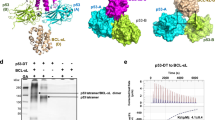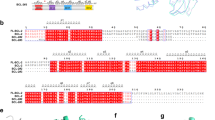Abstract
The tumour suppressor p53 plays a complex role in the regulation of apoptosis. High levels of wild type p53 potentiate the apoptotic response, while physiological range, low levels of the protein have an anti-apoptotic activity in serum starved immortalized fibroblasts. Here we report that primary fibroblast-like cells that show normal growth control are also efficiently protected from apoptosis by the endogenous p53 activity. The capacity to inhibit apoptosis is not restricted to the wild type protein: the R→H175 p53 mutant fully retains the anti-apoptotic activity of the wild type p53, providing a possible explanation for its high oncogenicity. Using a series of point and deletion mutants of p53 under the control of tetracycline-regulated promoter we show that certain mutants, like the wild type, protect cells at low levels but lead to apoptosis when overexpressed. This latter effect is lost upon deletion of a proline-rich domain in the NH2 part of the protein. The anti-apoptotic activity can be mapped to the extreme carboxy-terminal part of the protein and is therefore independent of other well characterized p53 activities. Our results add a new level of complexity to the network of interactions mediated by p53 in normal physiology and pathology.
This is a preview of subscription content, access via your institution
Access options
Subscribe to this journal
Receive 50 print issues and online access
$259.00 per year
only $5.18 per issue
Buy this article
- Purchase on Springer Link
- Instant access to full article PDF
Prices may be subject to local taxes which are calculated during checkout







Similar content being viewed by others
References
Abarzua P, LoSardo JE, Gubler ML, Spathis R, Lu Y-A, Felix A and Neri A. . 1996 Oncogene 13: 2477–2482.
Bates S and Vousden K. . 1996 Curr. Opin. Genet. Dev. 6: 12–18.
Blandino G, Levine AJ and Oren M. . 1999 Oncogene 18: 477–485.
Bowman T, Symonds H, Gu L, Yin C, Oren M and Van Dyke T. . 1996 Genes Dev. 10: 826–835.
Caelles C, Helmberg A and Karin M. . 1994 Nature 370: 220–223.
Canman C, Gilmer TA, Coutts SB and Kastan MB. . 1995 Genes Dev. 9: 600–611.
Chen J-Y, Funk WD, Wright WE, Shay JW and Minna J D. . 1993 Oncogene 8: 2159–2166.
Chen X, Ko LJ, Jayaraman L and Prives C. . 1996 Genes Dev. 10: 2438–2451.
Cho Y, Gorina S, Jeffrey PD and Pavletich NP. . 1994 Science 265: 346–355.
Deng C, Zhang P, Harper JW, Elledge SJ and Leder P. . 1995 Cell 82: 675–684.
Dittmer D, Pati S, Zambetti G, Chu S, Teresky AK, Moore M, Finlay C and Levine AJ. . 1993 Nature Genetics 4: 42–46.
Farmer G, Bargonetti J, Zhu H, Friedman P, Prywes R and Prives C. . 1992 Nature 358: 83–86.
Fourie AM, Hupp TR, Lane DP, Sang B-C, Barbosa MS, Sambrook JF and Gething M-JH. . 1997 J. Biol. Chem. 272: 19471–19479.
Franza BRJ, Maruyama K, Garrels JI and Ruley HE. . 1986 Cell 44: 409–418.
Friedlander P, Haupt Y, Prives C and Oren M. . 1996 Mol. Cell. Biol. 16: 4961–4971.
Friedlander P, Legros Y, Soussi T and Prives C. . 1996 J. Biol. Chem. 271: 25468–25478.
Goh HS, Yao J and Smiyth DR. . 1995 Cancer Res. 55: 5217–5221.
Gossen M and Bujard H. . 1992 Proc. Natl. Acad. Sci. USA 89: 5547–5551.
Gottlieb E, Haffner R, King A, Asher G, Gruss P, Lonai P and Oren M. . 1997 EMBO J. 16: 1381–1390.
Haffner R and Oren M. . 1995 Curr. Opin. Genetics Dev. 5: 84–90.
Hainaut P, Soussi T, Shomer B, Hollstein M, Greenblatt M, Hovig E, Harris C and Montesano R. . 1997 Nucleic Acids Res. 25: 151–157.
Hansen R and Oren M. . 1997 Curr. Opin. Cell Biol. 7: 46–51.
Hansen S, Hupp TR and Lane DP. . 1996 J. Biol. Chem. 271: 3917–3924.
Harvey D and Levine AJ. . 1991 Genes Dev. 5: 2375–2385.
Haupt Y, Rowan S, Shaulian E, Vousden KH and MO. . 1995 Genes Dev. 9: 2170–2183.
Hermeking H, Lengauer C, Polyak K, He T-C, Zhang L, Thiagalingram S, Kinzler KW and Vogelstein B. . 1997 Mole. Cell 1: 3–11.
Horikoshi N, Usheva A, Chen J, Levine AJ, Weinmann R and Shenk T. . 1995 Moll. Cell. Biol. 15: 227–234.
Hupp TR and Lane DP. . 1994 Curr. Biol. 4: 865–875.
Hupp TR, Meek DW, Midgley CA and Lane DP. . 1992 Cell 71: 875–886.
Hupp TR, Meek DW, Midgley CA and PLD. . 1993 Nucleic Acids Res. 21: 3167–3174.
Hupp TR, Sparks A and Lane DP. . 1995 Cell 83: 237–245.
Jayaraman L, Murthy KGK, Zhu C, Curran T, Xanthoudakis S and Prives C. . 1997 Genes Dev. 11: 558–570.
Kemp CJ, Donehower LA, Bradley A and Balmain A. . 1993 Cell 74: 813–822.
Kern SE, Pietenpol JA, Thiagalingam S, Seymour A, Kinzler KW and Vogelstein B. . 1992 Science 256: 827–830.
Ko LJ and Prives C. . 1996 Genes Dev. 10: 1054–1072.
Komarova EA, Chernov MV, Franks R, Wang K, Armin G, Zelnick CR, Chin DM, Bacus SB, Stark GR and Gudkov AV. . 1997 EMBO J. 16: 1391–1400.
Kremenetskaya OS, Logacheva NP, Baryshnikov AY, Chumakov PM and Kopnin BP. . 1997 Oncol. Res. 9: 155–166.
Lassus P, Ferlin M, Piette J and Hibner U. . 1996 EMBO J. 15: 4566–4573.
Lassus P and Hibner U. . 1998 Nuc. Acids Res. 26: 5233–5234.
Leroy-Viard K, Vinit M-A, Lecointe N, Jouault H, Hibner U, Roméo P.-H and Mathieu-Mahul D. . 1995 EMBO J. 14: 2341–2349.
Levine AJ. . 1997 Cell 88: 323–331.
Ludwig RL, Bates S and Vousden KH. . 1996 Mol. Cell. Biol. 16: 4952–4960.
MacCallum DE, Hupp TR, Midgley CA, Stuart D, Campbell SJ, Harper A, Walsh FS, Wright EG, Balmain A, Lane DP and Hall PA. . 1996 Oncogene 13: 2575–2587.
Mizushima S and Nagata S. . 1990 Nuc. Acids Res. 18: 5322.
Montes de Oca Luna R, Wagner DS and Lozano G. . 1995 Nature 378: 203–206.
Mosser DD, Caron AW, Bourget L, Denis-Larose C and Massie B. . 1997 Mol. Cell. Biol. 17: 5317–5327.
Murphy M, Hinman A and J LA. . 1996 Genes Dev. 10: 2971–2980.
Ory K, Legros Y, Auguin C and Soussi T. . 1994 EMBO J. 13: 3496–3504.
Pietenpol JA, Tokino T, Thiagaligam S, El-Deiry W, Kinzler KW and Vogelstein B. . 1994 Proc. Natl. Acad. Sci. USA 91: 1998–2002.
Polla BS, Kantengwa S, Françis D, Salvioli S, Franceschi C, Marsac C and Cossarizza A. . Proc. Natl. Acad. Sci. USA 93: 6458–6463.
Polyak K, Waldman T, He T-C, Kinzler K and Vogelstein B. . 1996 Genes Dev. 10: 1945–1952.
Polyak K, Xia Y, Zweler JL, Kinzler KW and Vogelstein B. . 1997 Nature 389: 300–305.
Ruaro E, Collavin L, Del Sal G, Haffner R, Oren M, Levine AJ and Schneider C. . 1997 Proc. Natl. Acad. Sci. USA 94: 4675–4680.
Sakamuro D, Sabbatini P, White E and Prendergast GC. . 1997 Oncogene 15: 887–898.
Scheffner M, Werness BA, Huibregtse JM, Levine AJ and Howley PM. . 1990 Cell 63: 1129–1136.
Schmid P, Lorenz A, Hameister H and Montenarh M. . 1991 Development 113: 857–865.
Sedman SA, Hubbert NL, Vass WC, Lowy DR and Schiller JT. . 1992 J. Virol. 66: 4201–4208.
Serrano M, Lin AW, McCurrach ME, Beach D and Lowe SW. . 1997 Cell 88: 593–602.
Shaulian E, Haviv I, Shaul Y and Oren M. . 1995 Oncogene 10: 671–680.
Shaulian E, Zauberman A, Ginsberg D and Oren M. . 1992 Mol. Cell. Biol. 12: 5581–5592.
Subler MA, Martin DW and Deb S. . 1994 Oncogene 9: 1351–1359.
Unger T, Mietz JA, Scheffner M, Yee CL and Howley PM. . 1993 Mol. Cell. Biol. 13: 5186–5194.
Vaziri H, West MD, Allsopp RC, Davison TS, Wu Y-S, Arrowsmith CH, Poirier GG and Benchimol S. . 1997 EMBO J. 16: 6018–6033.
Walker K and Levine AJ. . 1996 Proc. Natl. Acad. Sci. USA 93: 15335–15340.
Wang XW, Vermeulen W, Coursen JD, Gibson M, Lupold SE, Forrester K, Xu G, Elmore L, Yeh H, Hoeijmakers JHJ and Harris CC. . 1996 Genes Dev. 10: 1219–1232.
Wang Y, Reed M, Wang P, Stenger JE, Mayr G Anderson ME, Schwedes JF and Tegtmeyer P. . 1993 Denes Dev. 7: 2575–2586.
Wieczorek AM, Waterman JLF, Waterman MJF and Halazonetis TD. . 1996 Nature Med. 2: 1143–1146.
Yonish-Rouach E, Deguin V, Zaitchouk T, Breugnot C, Mishal Z, Jenkins JR and May E. . 1996 Oncogene 12: 2197–2205.
Acknowledgements
We are very grateful to Drs John Jenkins, Moshe Oren and Laurent Debussche for providing plasmids with mutant p53, Dr Nicole Basset-Seguin for the E6, Dr Chris Norbury for the CD2 expression vectors, Dr Alain Sarasin for the AS 198 cells and Dr Jean Marie Blanchard for the anti-GAPDH antibody. We thank Dr Bob Hipskind for comments on the manuscript. Supported by Association pour la Recherche contre le Cancer, Ligue Nationale contre le Cancer, INSERM and CNRS. P Lassus is a recipient of a fellowship from ARC.
Author information
Authors and Affiliations
Rights and permissions
About this article
Cite this article
Lassus, P., Bertrand, C., Zugasti, O. et al. Anti-apoptotic activity of p53 maps to the COOH-terminal domain and is retained in a highly oncogenic natural mutant. Oncogene 18, 4699–4709 (1999). https://doi.org/10.1038/sj.onc.1202841
Received:
Revised:
Accepted:
Published:
Issue Date:
DOI: https://doi.org/10.1038/sj.onc.1202841
Keywords
This article is cited by
-
Decision making by p53: life, death and cancer
Cell Death & Differentiation (2003)
-
The C-terminus of mutant p53 is necessary for its ability to interfere with growth arrest or apoptosis
Oncogene (2001)
-
A high constitutive level of NF-κB is necessary for the viability of mouse adenocarcinoma cells: A possible role of p53
Molecular Biology (2000)



